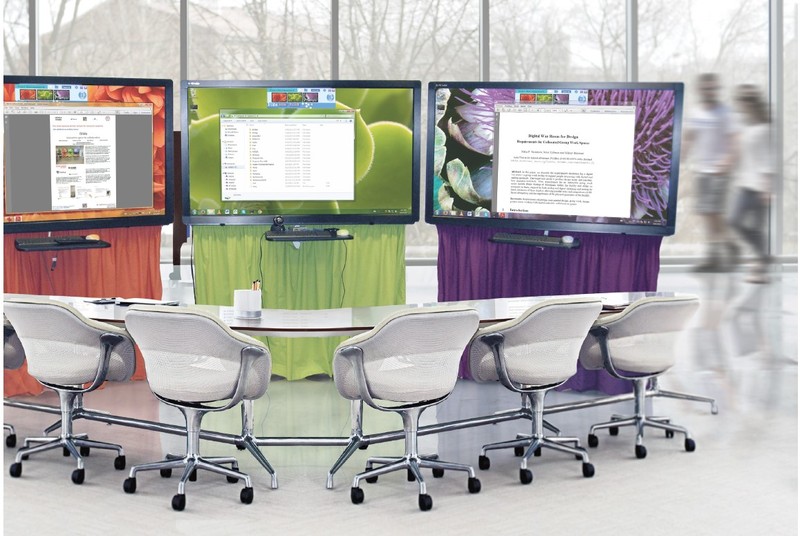Introduction and history
Learning objectives
- You know what Cross-Device Interaction means.
- You know some examples of developments of Cross-Device Interaction.
- You know examples of application domains of Cross-Device Interaction.
In this chapter, we strongly draw on the article Cross-Device Taxonomy: Survey, Opportunities and Challenges of Interactions Spanning Across Multiple Devices. You will be tasked to read the article in the fourth part of this chapter.
Introduction
Cross-Device Interaction (XDI) refers to using multiple interconnected devices to accomplish a task. Research in the area focuses on enabling seamless communication and data sharing between devices with the purpose of transcending beyond individual device and user. The work encompasses multi-monitor workstations, multi-device environments and spaces, and ad hoc mobile cross-device use.
Multi-monitor workstations
The history of XDI started in late 1980s when programmers commonly used a separate monochrome display for debugging and high-end video games enabled playing with several displays. As an example, the first Doom game allowed connecting three computers on a network for additional left and right views whereby the player could look left and right and see the view turned 90 degrees on a separate screen (connected to a separate computer). For personal computers, the first one to support multiple displays was the Macintosh II. Common x86 OS support for multi-displays was introduced in Windows 98.
First non-engineering professionals to adopt multiple displays may have been stock brokers with their multi-display setups (Fig. 1), factory control rooms, and emergency response centres (Fig. 2). The common denominator in these is a single person using a computer desktop system comprising of several (large) displays.


Multi-device environments and spaces
Sometimes adding more displays to a single computer is not enough. In this case, there is the need to enable fluent co-operation of several devices. One of the earliest examples of cross-device interaction was the Xerox ParcTab, which is a prototype tablet computer that was introduced in 1988. Xerox ParcTab was designed to communicate wirelessly with other devices and to provide access to context information such as the location of the user (see e.g. An Overview of the ParcTab Ubiquitous Computing Experiment).
Research in multi-device environments and spaces includes developing techniques for synchronizing data between devices, such as email and calendars. In part, this work also led to the development of technologies such as Bluetooth and Wi-Fi, which allowed devices to communicate with each other wirelessly.
One example of a multi-device environment is the Digital War Room for Design, which is a group work facility for collocated design teams allowing fluent sharing of documents, interaction with mobile devices and inbuilt memory function for past group activities (see Fig 3.). See also "Tila ryhmätyön tukena - DiWa-projektin loppuraportti" (unfortunately mostly in Finnish).

Ad hoc, mobile cross-device use
The increasing availability and use of smartphones and tablets has led to a significant increase in cross-device interaction research.
Overall, this area is perhaps best illustrated by the modern always-connected bring-your-own-device culture prominent everywhere. Fast ubiquitous networks allow portable devices to connect and interact with local services and systems in an intuitive manner. Portable devices can seamlessly access and use device-agnostic implementations of offered web services either as is, as simplified web applications, or through native apps designed for specific operating systems.
Further, recent advances have included the development of techniques for enabling communication between a wide range of devices, such as wearable devices and more broadly Internet of Things (IoT) devices.
Application domains
In a nutshell, XDI "spans across the research areas of distributed user interfaces, second-screen and multi-device research, and mobile multi-device ecosystems." and builds "... upon the scale of multi-display systems, display switching for multi-displays, interaction techniques for spontaneous device association, or characteristics of devices’ ownership, access, and distance" -- Cross-Device Taxonomy: Survey, Opportunities and Challenges of Interactions Spanning Across Multiple Devices
Thus, it is not perhaps surprising that there exists a myriad of application domains of XDI. These include:
- Knowledge work (e.g. using multi-display environments)
- Home Computing (e.g. interconnected home entertainment systems, shared calendars/planning tools, IoT devices such as washing machines and robot vacuum cleaners)
- Data Exploration (e.g. scientific visualization in a wide variety of domains)
- Mobile Computing (e.g. multi-factor authentication)
- Games and Installations (e.g. interactive museum installations, cross-play)
- Health (e.g. patient registration, patient workflow, activity monitoring)
- Software Development (e.g. debugging and programming)